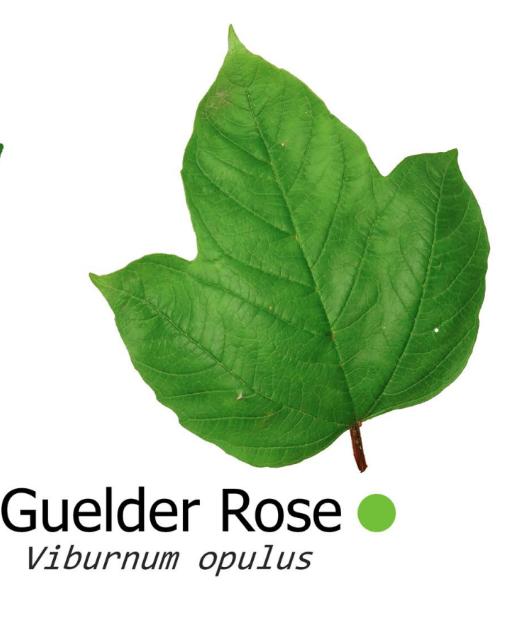A native deciduous shrub or small tree species in Ireland, commonly found in woodlands, hedgerows, and wetland areas.
Recognising the Guelder Rose Tree:
-
Leaves: The leaves of the Guelder Rose tree are opposite, palmately lobed, and serrated along the margins. They are dark green in color and turn shades of red and purple in autumn before falling.
-
Bark: The bark of the Guelder Rose tree is greyish-brown and develops shallow fissures and ridges with age. It has a rough texture and becomes more textured over time.
-
Flowers: Guelder Rose trees produce large, flat clusters of white flowers in late spring to early summer. The flowers have five petals and are attractive to pollinators such as bees, butterflies, and hoverflies.
-
Fruit: After flowering, Guelder Rose trees produce clusters of small, glossy red berries known as drupes. The berries are toxic to humans but are consumed by birds and other wildlife.
-
Habitat: Guelder Rose trees are commonly found in a variety of habitats, including woodlands, hedgerows, and wetlands. They prefer moist, well-drained soils and are often associated with other shrub and tree species.


5 Interesting Facts about the Guelder Rose Tree:
-
Medicinal Uses: Various parts of the Guelder Rose tree, including the bark, leaves, and berries, have been used in traditional medicine for their anti-inflammatory, diuretic, and febrifuge (to reduce fever) properties. However, caution should be exercised as some parts of the plant may be toxic if ingested.
-
Cultural Significance: The Guelder Rose tree has cultural significance in folklore and mythology. In some cultures, it was believed to have magical properties and was associated with protection, healing, and fertility rituals.
-
Wildlife Habitat: Guelder Rose trees provide habitat and food for a variety of wildlife species. Birds feed on the berries (drupes), while insects pollinate the flowers and feed on the nectar and pollen. Mammals such as deer may also browse on the foliage.
-
Ornamental Value: Guelder Rose trees are planted for ornamental purposes in parks, gardens, and landscapes, particularly for their attractive flowers, foliage, and berries. They are valued for their aesthetic appeal and ability to attract pollinators.
-
Hybridization: Guelder Rose trees are known to hybridise with other Viburnum species, resulting in a wide range of cultivars with varying flower colours, leaf shapes, and growth habits. This genetic diversity has contributed to the development of many cultivated varieties for ornamental purposes.
Uses of the Guelder Rose Tree:
-
Ornamental Planting: Guelder Rose trees are planted for ornamental purposes in parks, gardens, and landscapes, particularly for their attractive flowers, foliage, and berries. They are valued for their aesthetic appeal and ability to attract pollinators, making them popular choices for wildlife-friendly gardens.
-
Wildlife Habitat: Guelder Rose trees contribute to biodiversity by providing habitat and food for a variety of wildlife species. Their presence enhances habitat complexity and provides food, shelter, and nesting sites for birds, insects, and mammals, contributing to overall biodiversity in woodland, hedgerow, and wetland ecosystems.
-
Medicinal Uses: Various parts of the Guelder Rose tree, including the bark, leaves, and berries, have been used in traditional medicine for their anti-inflammatory, diuretic, and febrifuge (ro reduce fever) properties. Infusions, tinctures, and extracts made from Guelder Rose plant parts have been used to treat conditions such as fever, arthritis, and urinary tract infections.
Contribution to Biodiversity:
-
Habitat Provider: Guelder Rose trees create diverse micro-habitats that support a wide range of plant and animal species. Their presence enhances habitat complexity and provides food, shelter, and nesting sites for wildlife, contributing to overall biodiversity in woodland, hedgerow, and wetland ecosystems.
-
Pollinator Support: The flowers of Guelder Rose trees provide an important nectar and pollen source for pollinators such as bees, butterflies, and hoverflies. This supports pollinator populations and contributes to the health of ecosystems.
-
Seed Dispersal: Birds that feed on the berries (drupes) of Guelder Rose trees help disperse the seeds over a wide area through their droppings. This promotes the regeneration and spread of Guelder Rose trees in natural habitats, contributing to the diversity and resilience of woodland, hedgerow, and wetland ecosystems.
In summary, the Guelder Rose tree is recognisable by its lobed leaves, clusters of white flowers, and red berries. It holds cultural significance, provides valuable resources for wildlife, and contributes to biodiversity and ecosystem health in Ireland's woodlands, hedgerows, and wetland areas. Additionally, it serves as an important food source for birds and other wildlife, supports pollinator populations, and enhances habitat complexity in natural ecosystems.
Images taken from the beautiful posters created by Phil Barnett and you can download these and/or purchase other great designs from his online shop.
